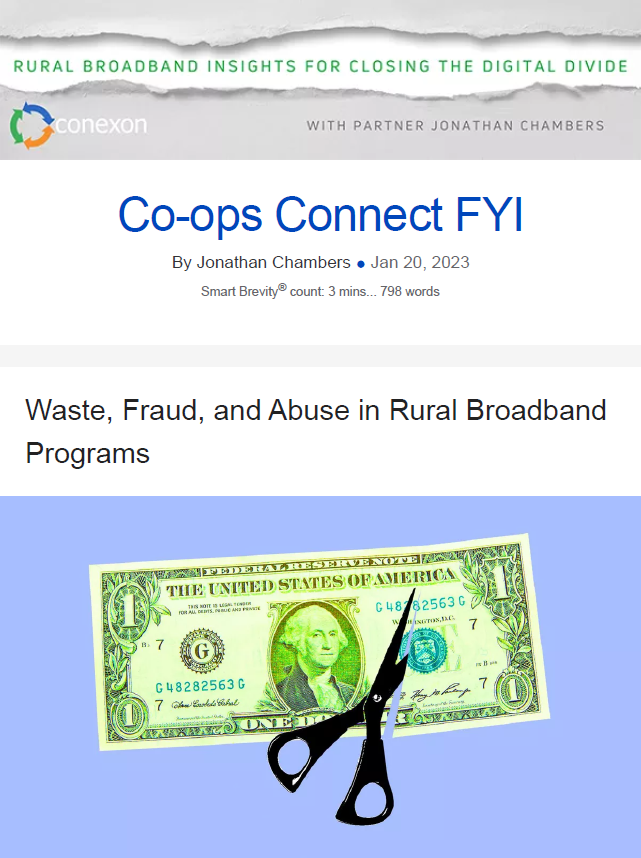Waste, Fraud, and Abuse in Rural Broadband Programs
January 20, 2023
When the House holds oversight hearings on waste, fraud, and abuse in rural broadband funding programs, will they focus on the right things?
Well, of course not, but let’s try to help anyway.
- The largest waste, fraud, and abuse in rural broadband programs has occurred due to underbuilding, which is spending on technologically inferior networks.
- Over the past seven years, the FCC wasted $20-30 billion on underbuilding and investment in inadequate copper, wireless, and satellite networks.
- And the waste continues to this day.
Underbuilding is the flip side of the coins of “overbuilding” and “technological neutrality.”
Waste in the eyes of the telephone and cable industry is usually couched in the tired term overbuilding.
- Overbuilding, in the pejorative sense, means public funding in an area that is already served.
- Yes, but: Unless you have great faith in the accuracy of the government’s broadband maps, “served” really means an ISP’s advertised availability of service unverified by objective testing.
Most policymakers have accepted an equally tired term: technological neutrality.
- “Neutrality” is a term promoted by those using underwhelming technologies that are often outdated and incapable of delivering the speed and capacity needed in rural America today.
The bottom line:
- No company deploying an advanced technology advocates for technological neutrality.
- Conexon and our co-op partners build and operate technologically superior networks.
The Problem with Underbuilding
While it is possible public money has been spent on new construction in already served areas, the far more common type of waste in rural broadband programs is due to underbuilding.
Underbuilding occurs when public money is spent on obsolete technology, or technology that quickly becomes obsolete, thereby requiring more spending in the same geographic area.
For example:
- Starting a decade ago, the first Connect America Fund program spent hundreds of millions in public money on 4 Mbps downstream/1 Mbps upstream broadband service.
- The second Connect America Fund program spent over $10 billion on 10 Mbps downstream/1 Mbps upstream broadband
service. - The first and second Alternative Connect America Model programs spent and continue to spend billions each year on 4/1 Mbps, 10/1 Mbps and 25/3 Mbps broadband.
- Then, the federal government spent more public money in the exact same places.
- The Rural Digital Opportunity Fund and American Rescue Plan Act are spending money in the exact geographic areas as the CAF I and CAF II, ACAM I and ACAM II programs.
The bottom line:
When technological change is rapid, you cannot keep pace by investing in today’s level of service. You must anticipate tomorrow’s service levels.
Federal Broadband Spending: A Cautionary Tale
Who could have thought demand for faster broadband speeds would grow so rapidly and dramatically?
Everybody in the industry, that’s who.
You may think it is far too difficult for the government to project demand in a rapidly changing industry like internet access. But that isn’t what happened.
- Government agencies were bullied by Congress and lobbyists to limit technological advancement in rural areas.
- Planned obsolescence was a feature, not a bug.
- Intentional underbuilding occurred most often when the funding was assigned on a sole source basis to incumbents, who had every incentive to keep feeding at the public trough.
Federal broadband waste in short review:
- When the FCC spent billions on 4/1 Mbps, the standard in the industry in urban and suburban areas was already 100 Mbps.
- When the FCC spent billion on 10/1 Mbps, the standard in the industry in urban and suburban areas was already 1 Gbps.
Why it matters:
- 4/1 Mbps, 10/1 Mbps, 25/3 Mbps or 100/20 Mbps were not technologically neutral speeds.
- They are speeds that reflected the limits of DSL at various distances between the DSLAM and the end user.
- 100/20 Mbps reflected the limits of cable DOCSIS 3.0 and 3.1, particularly the upload speeds.
The Big Questions
Who thinks it is a good idea to spend money on obsolescence?
- Shouldn’t we want infrastructure investments to last for a decade or longer?
- I’d prefer that public money be spent on infrastructure that will last for thirty years, but I’d settle for ten.
How do we know what will become the new standard for broadband in 10 years?
- How about merely looking at what more advanced companies are deploying today? Multi-gigabit symmetrical service.
So, what will BEAD be spent on? Which way do you think state governments will lean?
- Over 25 years ago, Congress directed state and federal agencies to ensure that rural areas would receive service comparable to service available in urban areas.
- That standard for new broadband construction in urban and suburban areas is multi-gigabit symmetrical service.
That seems about right to me.
